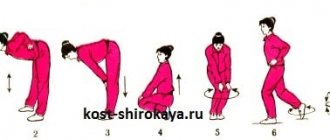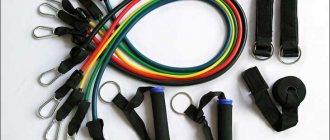Most people start training with enthusiasm and the intention of doing everything right and as efficiently as possible. Therefore, they conscientiously conduct a warm-up and only then move on to the main part. But during these 40-90 minutes, significant changes occur in the body, organism and psyche. Stress causes the heart to beat faster, the muscles to tense, physical performance gradually decreases, and fatigue sets in.
As a result, such a concept as a hitch is simply forgotten. After all, you really want to drink water and dive straight into the shower. But this connivance then costs too much - unbearable soreness and deterioration of the general condition. That's why it's so important to take these 10 minutes.
What is a cool down
A cool-down is a light load after training for a gradual (and therefore safe) transition of the body from an excited state to a resting state. Includes a set of dynamic and static exercises. Some people successfully use running or orbitrek for this purpose. Needed for:
- relief of soreness.
- faster muscle recovery;
- reducing stress for the body after intense training;
- restoration of breathing, pressure, heart rate;
- preventing blood stagnation in blood vessels;
- removing stress from the heart;
- normalization of body thermoregulation;
- relaxation of all muscle groups;
- psychological comfort.
If you have doubts about the effectiveness and benefits of a cool-down, do one workout without it, and the next with it. By comparing the results (sensations, well-being, strength), you will draw a conclusion from your own experience: this is an obligatory and necessary part of any lesson.
WHY DO YOU NEED A COOL-DOWN?
American physiologists claim that the post-training phase is one of the most important in any sports program. A rapid transition from an active to a passive state has a bad effect on the effectiveness of exercise and on health in general.
Let's figure out what happens when we abruptly end a workout.
- The load on the heart increases
During active exercise, muscles contract dynamically and help the heart pump blood. When this activity stops abruptly, all the work of circulating blood falls on the heart. He has to fight even harder and more intensely than in training. If you are in poor shape or have chronic heart failure, you risk making your problems worse.
- Blood circulation is impaired
When the heart fails to restore blood circulation after an abrupt end to a workout, blood stagnates in the muscles. Nutrients and oxygen stop flowing to the brain and internal organs. This leads to dizziness, nausea and fainting.
The muscles do not receive enough nutrients and do not grow. In addition, lactic acid accumulates in them - the cause of post-workout pain.
- Blood pressure and temperature drop sharply
During intense exercise, body temperature can reach 38 degrees, which is why it is so important to properly “cool down” the body after training before going outside or taking a shower. Too cold or hot water can affect your blood pressure (which also increases during exercise) and cause fainting.
How to do it correctly
To benefit from a cool-down, you need to know how to do it correctly. To do this, you should take into account several generally accepted rules.
- Perform immediately after finishing the main part of the workout, without pausing.
- Pay special attention to those muscles that received the main load.
- Start with large muscles and end with small ones.
- The duration of fixation during stretching is about 30 seconds.
- There should be no pain - only mild discomfort is allowed.
- Alternate statics with dynamics.
- To relax the spine, hang on the bar for half a minute (2 approaches with a short rest interval).
- All transitions are smooth.
- Breathing is intense and deep.
- Total time - no more than 10 minutes.
Many coaches and professional athletes believe that the cool-down does not end after completing the last exercise (usually stretching). If you are studying at home, you need to take a warm bath, if in the hall - a contrast shower. They will complete the anti-stress effect for the muscles, body, and psyche and will help you recover faster.
In what cases is a cool-down necessary and is stretching important?
Experienced athletes assure that a cool-down is a must after any workout that can cause an increase in heart rate. Most often, it is newcomers to sports who feel the body’s urgent need for a cool-down, while experienced athletes often neglect this stage, which becomes the main reason for harm to health.
If you do not neglect the cool-down, you can make your heart more resilient to stress. It is wrong to overload the heart muscle without worrying about how to properly get out of such a stressful state for the body. In addition, stretching exercises are no less necessary after training. They will allow you to achieve the following results:
- additionally relieve muscle tension after exercise;
- speed up muscle fiber recovery processes;
- will help improve your appearance and make your muscles elastic;
- Stretching strengthens the ligaments, they become more elastic.
Exercises
Traditional dynamic exercises after training should be performed as slowly as possible, without jerking:
- swing your arms;
- turns to the sides;
- bending to the sides and forward;
- dynamic squats
- lunges.
After the dynamics, static stretching is performed. The basis for the cool-down can be taken from stretching or yoga:
- incomplete twists;
- sumo stand;
- martin;
- half squat;
- sitap;
- static hyperextension;
- a chair against the wall;
- cat;
- V-stabilization.
Don’t forget also about breathing exercises, which fit perfectly into the anti-stress post-workout complex.
How to properly cool down after a workout
The structure of the cooldown looks like this:
- Light short cardio (exercise bike or walking) – 5 minutes
- Stretching all major muscle groups, or only those that participated in the workout – 5-10 minutes
- Breathing exercises – 1-2 minutes
However, a cool-down after a workout in the gym is an individual thing, and each student adapts it to suit himself.
For example, someone does not do light cardio, but devotes more time and effort to developing flexibility or breathing exercises from the yoga arsenal.
The choice is always yours. Let your intuition and sports experience tell you what to pay more attention to during the cool-down.
Approximate diagram
Regardless of the type of training performed, the cool-down can be structured according to the following scheme.
Light cardio
Objective: normalize blood circulation.
Exercises:
- low intensity jumping;
- run
- squats;
- jumping rope;
- walking
- bends;
- turns;
- swing your arms and legs.
The body prepares for a safe transition from an intense pace to a state of rest.
Breathing exercises
Task: normalize breathing.
Exercises:
- breathing for 4 counts;
- depth: deep and slow inhalations and exhalations with a retracted and absolutely motionless abdomen;
- Sphinx: belly breathing in a sitting position;
- wave: alternate breathing with the chest and stomach in a lying position.
The blood is saturated with oxygen, the central nervous system comes to a state of rest, and muscle spasms are eliminated.
Stretching
Objective: to give elasticity to muscles and tendons. Exercises:
- child's pose;
- downward facing dog pose;
- hanging extension;
- inverted back stretch;
- camel pose;
- backbends;
- pigeon pose;
- deep lunges.
Tense muscle fibers relax, blood vessels become toned.
At the end, you can perform several shaking movements, patting and rubbing, which have a massage effect. They have a general strengthening effect.
Is it possible to skip this step or not?
Not everyone considers a cool-down to be a necessary element of training. Some reduce its duration as much as possible, while others refuse to carry it out altogether. This, of course, will not lead to critical consequences, but it can create some problems:
- After a strenuous workout, muscles will hurt longer and more intensely;
- You will need more time to rest;
- The risk of colds will increase with temperature changes. For example, if you go out into the cold air warmed up after a workout, the chance of catching a viral infection is higher than after a cool-down;
- If insufficient blood flow in the digestive tract and other organs, formed during a period of intense muscular work, persists for a long time, this will result in disruption of its function - inflammatory diseases, slower peristalsis, esophageal reflux;
- The functioning of the cardiovascular system may be disrupted. In young healthy people, most likely, there will be no problems, but with pathologies such as heart failure, arrhythmia, coronary heart disease, an abrupt cessation of training will cause a deterioration in well-being;
- There is also a risk of a rapid drop in blood pressure, which can lead to dizziness, blurred vision, and even short-term loss of consciousness.
As a rule, experienced athletes prefer to do a cool-down after training, because they have experienced all the disadvantages of abruptly stopping exercise. Intense physical work in itself is stressful for the body, and a rapid transition to a resting state can aggravate this stress. A gentle attitude towards your own body will help you achieve better results and make training a more enjoyable pastime.
Examples
Considering the different focus of training, locations and gender, take an example of a cool-down for your case as a guide.
Cool down after strength training
Objective: restore elasticity to stressed muscles, relieve spasms, reduce soreness the next day.
- Light jogging/jumping rope.
- Swing your arms in a circular motion forward and backward.
- Body tilts forward, backward and to the sides.
- Rotate your head in different directions.
- Stretch up.
- Bend your body forward, touching your toes with your fingers.
- Squats.
- Patting with the palm of those muscles that received the main load.
- Concussive movements with arms, legs, and entire body.
You can finish with any fitness yoga pose
Cool down after running
Objective: gradually remove the load from the cardiovascular system.
- Walking.
- Hip rotations.
- Swing your legs.
- Lunges.
- Rifles.
- Fold.
- Transverse stretch.
You can finish with shaking movements with your arms, legs, and entire body.
After football practice
In one of his interviews, the famous English football player David Beckham told how to properly cool down after a game.
- Intense jogging - 1 minute.
- Go to medium pace - 1 minute.
- Slow jog - half a minute.
- Walking - half a minute.
- Raising your knees and jumping in place - 2 minutes.
- Stretching the lower leg, back of the thigh, quadriceps, groin, pelvis, back, neck - 5 minutes.
Beckham recommends ending your cool-down with a warm, relaxing bath.
After training in the gym
When working out in the gym, you need to use exercise equipment for an effective cool-down.
- Treadmill with a gradual decrease in pace - 3 minutes.
- Hanging extension - 2 sets of half a minute each with a 15 second rest interval.
- Work in the simulator that was the main one during the training. 1-2 basic exercises are selected and performed at the slowest possible pace, without jerking or strong tension, with minimal weights. 3 minutes.
- Orbitrek - 3 minutes.
- Cold and hot shower.
An example of working with simulators. Let's say there was an ab workout. Lie down on an incline bench. Cross your arms, lift your body, twisting it slightly towards your left or right knee. But you don’t complete the exercise. As soon as you felt a slight tension in the muscles, you slowly leaned your body back.
After training at home
Here the choice of exercises is practically unlimited.
- Walking in place.
- Low intensity jumping.
- Squats.
- Head rotation.
- Scissors by hand.
- Body rotations.
- Bend forward.
- Lunges.
- Several yoga asanas (cobra, child's pose, camel).
- Rubbing the muscles that bear the main load.
Then it is recommended to take a contrast shower or a warm bath. After this, it is advisable to remain at rest for at least half an hour.
For men
Men usually work with a specific muscle group. This determines the choice of exercises for them. The beginning is traditional - jogging with a gradual decrease in pace. Then breathing exercises and hanging on the horizontal bar. After this, 5 minutes of stretching:
- neck and chest, if this was a workout to pump up the upper body;
- biceps and triceps, if you built up arm muscles;
- back and abs, if you pumped up abs on your stomach;
- quadriceps, if you worked on the leg muscles.
For men, the cool-down must be completed with light shaking and rubbing of those muscles that bore the main load.
For girls
Girls most often exercise to maintain their figure and control weight or to lose weight. Therefore, for them, the basis of the cool-down after training should be breathing fat-burning exercises and stretching.
- Walking in place.
- 2-3 breathing exercises.
- Swing your arms and legs.
- Tilts.
- Rotates the body in different directions.
- Several yoga asanas for stretching: mountain, cobra, child, warrior, dog (looking down and up), triangle, etc.
Cooling down is a useful and effective part of any workout. Therefore, it must be included in every lesson, not to be lazy, not to forget about it, and most importantly, to leave strength for it. These are those 10 minutes that at first seem like an insignificant detail, but then turn out to be an excellent relaxation that allows you to truly enjoy the sport. The good health and high spirits that this complex gives help you not to break down and achieve your goals without injuries and chronic fatigue.
Why do you need a cool down after training?
A cool-down after training is a must! It helps to quickly bring the body into a calm state.
During the main part of the training session, a set of strength exercises is performed. This is an intense load that is stressful for the body.
Training stress affects the human body in several directions at once:
- There is a powerful release of hormones into the circulatory system
Strength loads promote the production of the anabolic hormone testosterone, which triggers the mechanism of muscle growth.
But at the same time, stress hormones are released into the blood - adrenaline, norepinephrine and cortisol. Their prolonged presence in the bloodstream provokes the destruction of muscle tissue.
- The load on the musculoskeletal system increases, the central nervous system (CNS) is excited, and the pulse rate and blood pressure can significantly increase.
After such a shake-up, the body returns to normal and recovers for a long time (from 1 to 3 days).
Cooling down after strength training is aimed at accelerating recovery time and bringing the body back to normal. This applies to all stress factors.
For example, in people who do not cool down after exercise, the state of overexcitement can last for hours. For those who did not neglect this part, the central nervous system normalizes its work in 20-30 minutes.
The same thing happens with stress hormones. If you do not cool down and calm this “cocktail”, then by inertia they can be released into the blood for a long time, continuing their destructive effect.
This also applies to the circulatory system - reducing heart rate and normalizing blood pressure.
Remember that a cool-down after training accelerates the recovery of ligaments and muscles, and therefore the growth of muscle mass and strength.
The benefits of cool-downs for muscles
During exercise, our muscles contract. To increase in volume, muscles have to sacrifice their length (very, very simplified).
As you know, muscle growth begins only after the muscle is restored. It turns out that before our body returns the muscle to its former length, the process of muscle growth will not begin.
.
What will happen if we train muscles faster than they have time to restore length? That's right, the muscles will remain in a contracted form. To begin with, this will cause unusual inconvenience to our musculoskeletal system, because the joints are designed for one length of muscle fibers, and we will voluntarily reduce this length with training without a hitch and stretching. As a result, we become less mobile (like koalas in a fleshy shell) and create additional stress on our joints. Which, by the way, training with weights doesn’t bring anything good anyway. This can be compared to wearing a suit a couple sizes smaller.
It’s a completely different matter when our muscles undergo a systematic cool-down after training with stretching elements. Muscles recover much faster and therefore begin to grow earlier . The flexibility of both muscle tissue and joint joints increases. We can do the exercise with a greater amplitude, which means we can load the muscles better, and as a result, get a better athletic result. In addition, thanks to the cool-down, blood circulation improves , the trained muscles receive more oxygen through the blood, and this, of course, has a positive effect on muscle growth. Normalization of blood supply supplies our muscles with an increased amount of nutrients .
In addition to all the above advantages, it should be noted that due to the fact that the muscle becomes longer, its growth potential certainly increases. After all, there is more room for growth! I wrote about all this in more detail here.
Well, to all of the above, you should also add the removal of lactic acid from the muscles through a cool-down. This very acid makes our muscles ache the day after training. After all, you and I are familiar with these sensations: muscle aches, decreased joint mobility. It feels like the muscle is simply being squeezed from the inside, and any hint of stretching brings not the most pleasant feelings. I assure you, if you systematically do a cool-down after training, you will soon forget about this trouble.
From the entire text above, I propose to summarize the goals for which we need to do a cool-down after training in the gym.
Warm-up before leg training: 20 exercises
Preparation for the planned lesson is gradual - you cannot work at once at a wide amplitude. Warming up before leg training contains a whole arsenal of exercises. They activate the buttocks, quadriceps and hamstrings, adductors, and calves.
This set of exercises is also suitable for warming up before the splits. The only recommendation: repeat the cardio exercises in three sets to better warm up the muscles and ligaments before stretching into the splits. A well-warmed body will make it easier for you to stretch. To do this, look at: warm-up option FOR THE WHOLE BODY for 5 minutes.
Walking in place with knees raised
Start warming up your legs with regular walking in place. Take a classic sports stance - stand straight, hands at your sides, and feet slightly narrower than shoulder width. Alternately raise and lower your legs, move your bent arms along your body. Hips reach parallel to the floor. Maintain an average pace, don't rush anywhere.
How much to do: 10-15 lifts on each leg.
U-turns with arm extension
The movement is included in the pre-workout warm-up to prepare the core muscles, which are always involved during leg workouts. Take a position - spread your feet two shoulder widths apart, place your arms on your sides. Make a turn to the left, extend your straight right arm in that direction, and stand back up. Mirror, perform alternately, without pauses.
How much to do: 5-10 abductions for each arm.
Mill
Place your feet two shoulder widths apart, keep your body straight, straighten your elbows, and stretch your arms to the sides. Start bending over, twisting your body. With your right hand, reach for your left toe, stand up straight, do the same tilt in the other direction, and take the starting position. Don't bend your knees, don't crook your arms.
How much to do: 5-10 bends on each side.
Rotational movements in the hip joint
Place your feet at a distance of one and a half shoulder widths from each other, place your palms on your waist, on your sides. Start a rotational movement of your pelvis in the right direction (forward, right, back, left). Keep your head in place, do not bend your knees, do not lift your toes or heels. Repeat the rotation to the left.
How much to perform: 5-10 clockwise rotations and 5-10 counterclockwise rotations.
Standing Cat Pose
A variation of the classic cat pose. The modification is as follows: stand on your feet and place your palms on your thighs just above your knees. Bend your lower back, then round your back. The neck is straight and follows the trajectory. Spring your knees and firmly press your feet to the floor so as not to lose your balance.
How much to do: 10-15 arches.
Leg spins
Take a classic stance with your feet shoulder-width apart. Raise one leg until your thigh is parallel to the floor and your shin is at a right angle to it. Exactly, without changing the plane, turn your leg clearly to the side, make a rotation. Perform the warm-up exercise first on the right leg, then on the left leg.
How much to perform: 5-10 rotations on each leg clockwise and 5-10 rotations on each leg counterclockwise.
Circular rotations in the knee joints
This is a must-have movement for warming up before any workout that involves squats, lunges, or deadlifts. Stand up, place your palms on your thighs above your knees, and keep your feet together. Incline your body a little, squat slightly, rotate your knees in one direction or the other.
How much to perform: 5-10 clockwise rotations and 5-10 counterclockwise rotations.
Squat with arms thrown from bottom to top
Place your feet at a distance convenient for squats, raise your straightened arms up above your head. Begin to lower your pelvis until it is parallel to the floor, without bringing your knees behind your toes. At this time, move your hands between your legs to the middle of your shins. Rise to starting position, repeat.
How much to do: 10-15 squats.
In the leg warm-up, you can perform a simplified version of squats:
Lateral lunges with weight transfer
Effective for warming up the legs, as every muscle is captured. Stand with your feet far apart. Shift your center of gravity to the left side, bend your knee and lower your pelvis until it is parallel to the floor. Return to the original stand. Mirror without lifting your feet. Clasp your hands in front of you. Side lunges are great for warming up before doing the splits.
How much to do: 5-10 lunges on each side.
Rotations to warm up the ankles
The ankles are extremely vulnerable, so you should not forget about this place when warming up your legs. Place your feet slightly wider than shoulder-width apart and place your palms on your sides. Raise your left leg and perform a series of ankle rotations to the right and left. Do the same steps with the second leg.
How much to perform: 5-10 rotations on each leg clockwise and 5-10 rotations on each leg counterclockwise.
Cross swings at the support
Stand to the side of any support (such as a chair or wall). Place one hand on the support and the other on the belt. Move the leg farthest from the support to the side. Make a swing, bring it back and, bypassing the starting position, swing in front of the second leg. Keep your body level and position your pelvis clearly, do not wiggle. Switch sides and repeat the cross swing.
How much to do: 5-10 swing lunges on each leg.
Swing back and forth at the support
Stand to the side of a support (such as a chair or wall). Place one hand on the support, the other on the belt. At a moderate pace, begin to swing the leg farthest from the support forward and backward to the level of the pelvis. Pull the toe slightly towards you, bend your knee slightly. Perform for the second leg. These swings are great for warming up before the splits.
How much to do: 5-10 swing lunges on each leg.
Back lunges with arms raised
Take a normal stance with your arms along your body. Place one leg on your toes straight back, at an angle of 90 degrees between the shin and thigh, and place the other perpendicular to the floor at the knee joint. Raise your arms above your head as you step back. Push off, come back. Do this alternating legs.
How much to do: 5-10 lunges on each side.
In the leg warm-up, you can perform a simplified version of lunges:
Squat lean towards straight leg
Place one leg straight forward on your heel, bend the other slightly at the knee. Raise your opposite hand up above your head and place the other on your waist. Perform a cross tilt, reaching your toes with your fingers. Mirror it. This leg warm-up exercise is simple and very useful, as it warms up the hamstrings well.
How much to do: 5-10 bends on each side.
Pulling the thigh to the chest
Place your feet shoulder-width apart and keep your torso straight. Begin to slowly raise your leg, bent at the knee joint, towards your chest. Grab her at the level of the pelvis with your hands and pull her harder. Feel the stretch in your hamstrings. Repeat this with the other leg.
How much to do: 5-10 pull-ups on each side.
Pulling the lower leg towards the buttocks
Take a classic stance. Bend one leg at the knee and gently pull your heel toward your buttock, wrapping your arms around it to complete the movement. To better stretch the quadriceps femoris, make an effort and increase the amplitude. Do not overdo it so as not to injure muscle fibers.
How much to do: 5-10 pull-ups on each side.
Pulsating Tilts
Stand straight, move your feet to the distance for squats, stretch your arms up. Bend in the following sequence: to the right toe, in the center between the feet, to the left toe. Go back. Feel the tension in the back of your thigh. Don't bend your knees.
How much to do: 5-10 bends.
Imitation of jumping rope
Take a stance as for jumping rope - feet slightly apart, arms bent at the elbows, hands out to the sides. Jump in place, pushing off with both feet. Imagine doing this with a jump rope and start rotating your arms a little. Spring your knees, do not keep them straight.
How many to perform: 25-30 jumps.
Jumping Jack
Starting position – feet together, hands at your sides. Make a simultaneous jump with your legs spread to a greater distance and bring your palms together above your head. With one more jump, return to your original position. This dynamic exercise is great for an intense pre-workout warm-up.
Repeat the jump rope and jumping jack for 3 sets if you are warming up for the splits to better warm up your body.
How many to perform: 25-30 jumps.
Bends to calm your heart rate
Stand up straight, spread your feet slightly wider than your shoulders. Relax and lean towards your toes, shake yourself up, straighten up and raise your arms above your head. Do the exercise slowly, without sudden movements. Performed to restore breathing and smooth transition from warming up the legs to the main part of the lesson.
How much to do: 7-10 bends.










